Discrimination at Work: Equal Pay and the Gender Pay Gap in Australia
VerifiedAdded on 2020/12/26
|5
|1529
|130
Case Study
AI Summary
This case study analyzes the gender pay gap and workplace discrimination issues prevalent in Australia, specifically focusing on the Aboriginal and Torres Strait Islander communities. It highlights the disparity in pay scales and opportunities between male and female Indigenous employees, even within organizations like QUT. The study explores the impact of discrimination on these communities, including the experiences of racism and unequal treatment. It discusses initiatives taken by QUT, such as the Indigenous Employment Strategy, and the role of government legislation like the Racial Discrimination Act and Workplace Gender Equality Act. The case study emphasizes the need for equal opportunity and the elimination of discriminatory practices to improve the living standards and career prospects of Indigenous Australians. The analysis draws from various sources and reports, providing a comprehensive overview of the challenges and potential solutions to address gender and racial discrimination in the workplace.
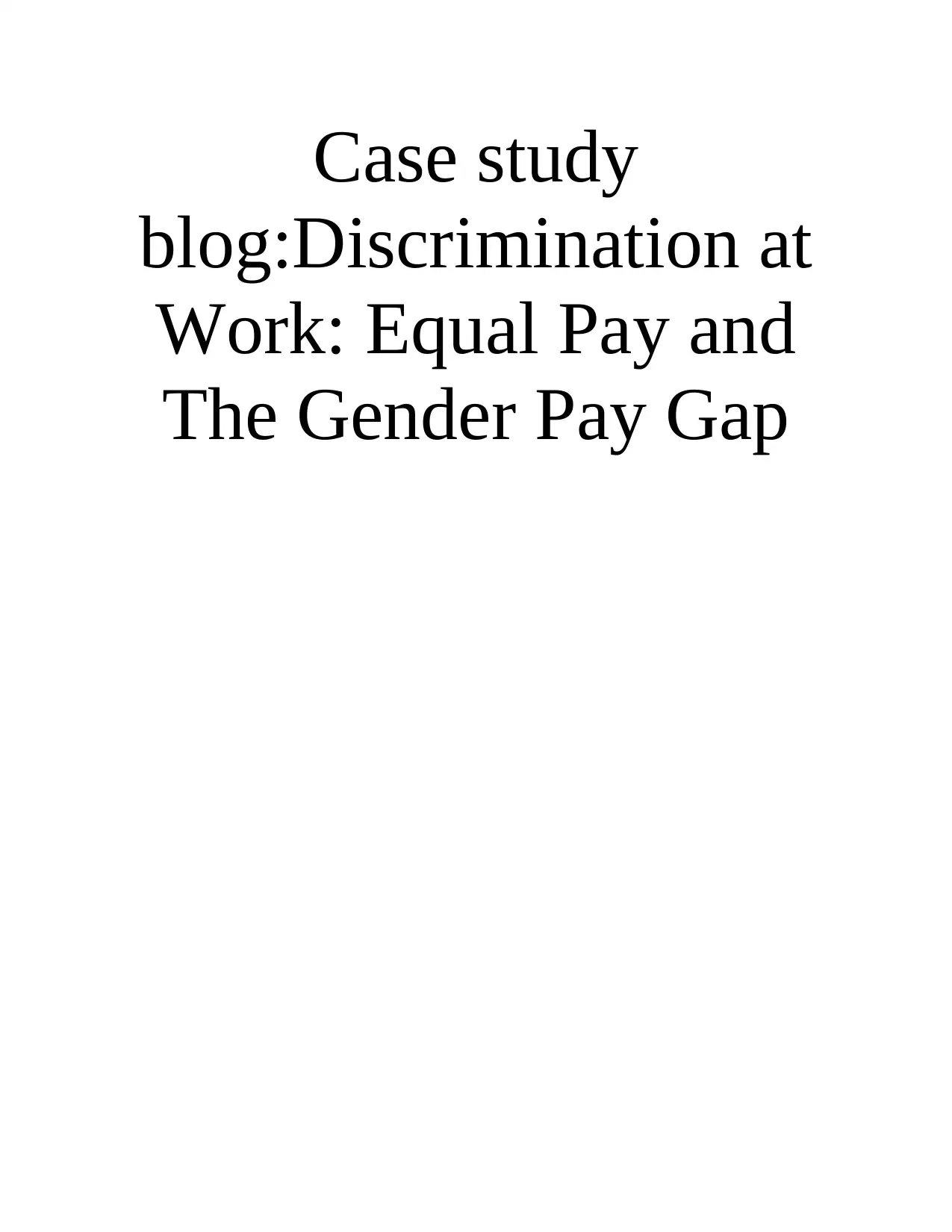
Case study
blog:Discrimination at
Work: Equal Pay and
The Gender Pay Gap
blog:Discrimination at
Work: Equal Pay and
The Gender Pay Gap
Paraphrase This Document
Need a fresh take? Get an instant paraphrase of this document with our AI Paraphraser
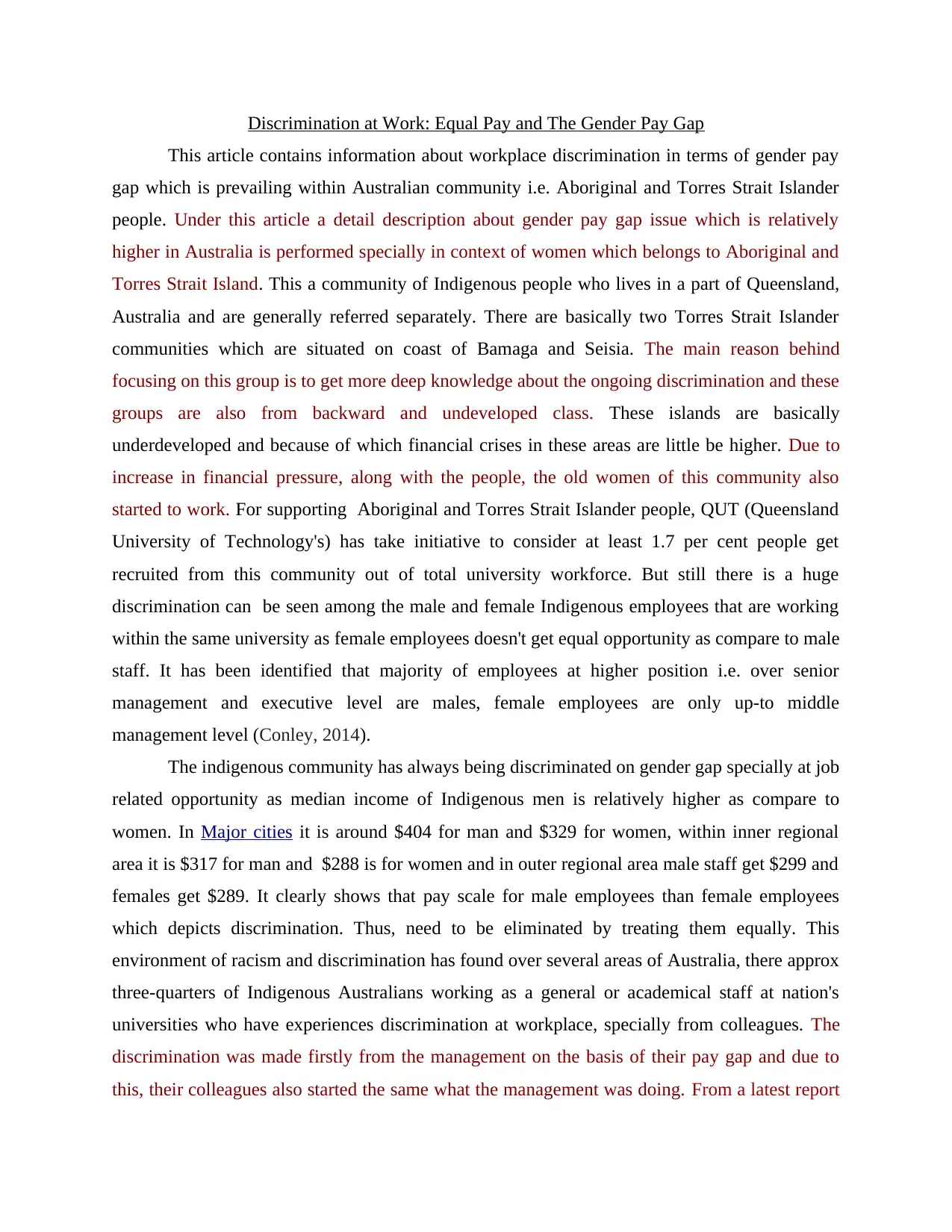
Discrimination at Work: Equal Pay and The Gender Pay Gap
This article contains information about workplace discrimination in terms of gender pay
gap which is prevailing within Australian community i.e. Aboriginal and Torres Strait Islander
people. Under this article a detail description about gender pay gap issue which is relatively
higher in Australia is performed specially in context of women which belongs to Aboriginal and
Torres Strait Island. This a community of Indigenous people who lives in a part of Queensland,
Australia and are generally referred separately. There are basically two Torres Strait Islander
communities which are situated on coast of Bamaga and Seisia. The main reason behind
focusing on this group is to get more deep knowledge about the ongoing discrimination and these
groups are also from backward and undeveloped class. These islands are basically
underdeveloped and because of which financial crises in these areas are little be higher. Due to
increase in financial pressure, along with the people, the old women of this community also
started to work. For supporting Aboriginal and Torres Strait Islander people, QUT (Queensland
University of Technology's) has take initiative to consider at least 1.7 per cent people get
recruited from this community out of total university workforce. But still there is a huge
discrimination can be seen among the male and female Indigenous employees that are working
within the same university as female employees doesn't get equal opportunity as compare to male
staff. It has been identified that majority of employees at higher position i.e. over senior
management and executive level are males, female employees are only up-to middle
management level (Conley, 2014).
The indigenous community has always being discriminated on gender gap specially at job
related opportunity as median income of Indigenous men is relatively higher as compare to
women. In Major cities it is around $404 for man and $329 for women, within inner regional
area it is $317 for man and $288 is for women and in outer regional area male staff get $299 and
females get $289. It clearly shows that pay scale for male employees than female employees
which depicts discrimination. Thus, need to be eliminated by treating them equally. This
environment of racism and discrimination has found over several areas of Australia, there approx
three-quarters of Indigenous Australians working as a general or academical staff at nation's
universities who have experiences discrimination at workplace, specially from colleagues. The
discrimination was made firstly from the management on the basis of their pay gap and due to
this, their colleagues also started the same what the management was doing. From a latest report
This article contains information about workplace discrimination in terms of gender pay
gap which is prevailing within Australian community i.e. Aboriginal and Torres Strait Islander
people. Under this article a detail description about gender pay gap issue which is relatively
higher in Australia is performed specially in context of women which belongs to Aboriginal and
Torres Strait Island. This a community of Indigenous people who lives in a part of Queensland,
Australia and are generally referred separately. There are basically two Torres Strait Islander
communities which are situated on coast of Bamaga and Seisia. The main reason behind
focusing on this group is to get more deep knowledge about the ongoing discrimination and these
groups are also from backward and undeveloped class. These islands are basically
underdeveloped and because of which financial crises in these areas are little be higher. Due to
increase in financial pressure, along with the people, the old women of this community also
started to work. For supporting Aboriginal and Torres Strait Islander people, QUT (Queensland
University of Technology's) has take initiative to consider at least 1.7 per cent people get
recruited from this community out of total university workforce. But still there is a huge
discrimination can be seen among the male and female Indigenous employees that are working
within the same university as female employees doesn't get equal opportunity as compare to male
staff. It has been identified that majority of employees at higher position i.e. over senior
management and executive level are males, female employees are only up-to middle
management level (Conley, 2014).
The indigenous community has always being discriminated on gender gap specially at job
related opportunity as median income of Indigenous men is relatively higher as compare to
women. In Major cities it is around $404 for man and $329 for women, within inner regional
area it is $317 for man and $288 is for women and in outer regional area male staff get $299 and
females get $289. It clearly shows that pay scale for male employees than female employees
which depicts discrimination. Thus, need to be eliminated by treating them equally. This
environment of racism and discrimination has found over several areas of Australia, there approx
three-quarters of Indigenous Australians working as a general or academical staff at nation's
universities who have experiences discrimination at workplace, specially from colleagues. The
discrimination was made firstly from the management on the basis of their pay gap and due to
this, their colleagues also started the same what the management was doing. From a latest report
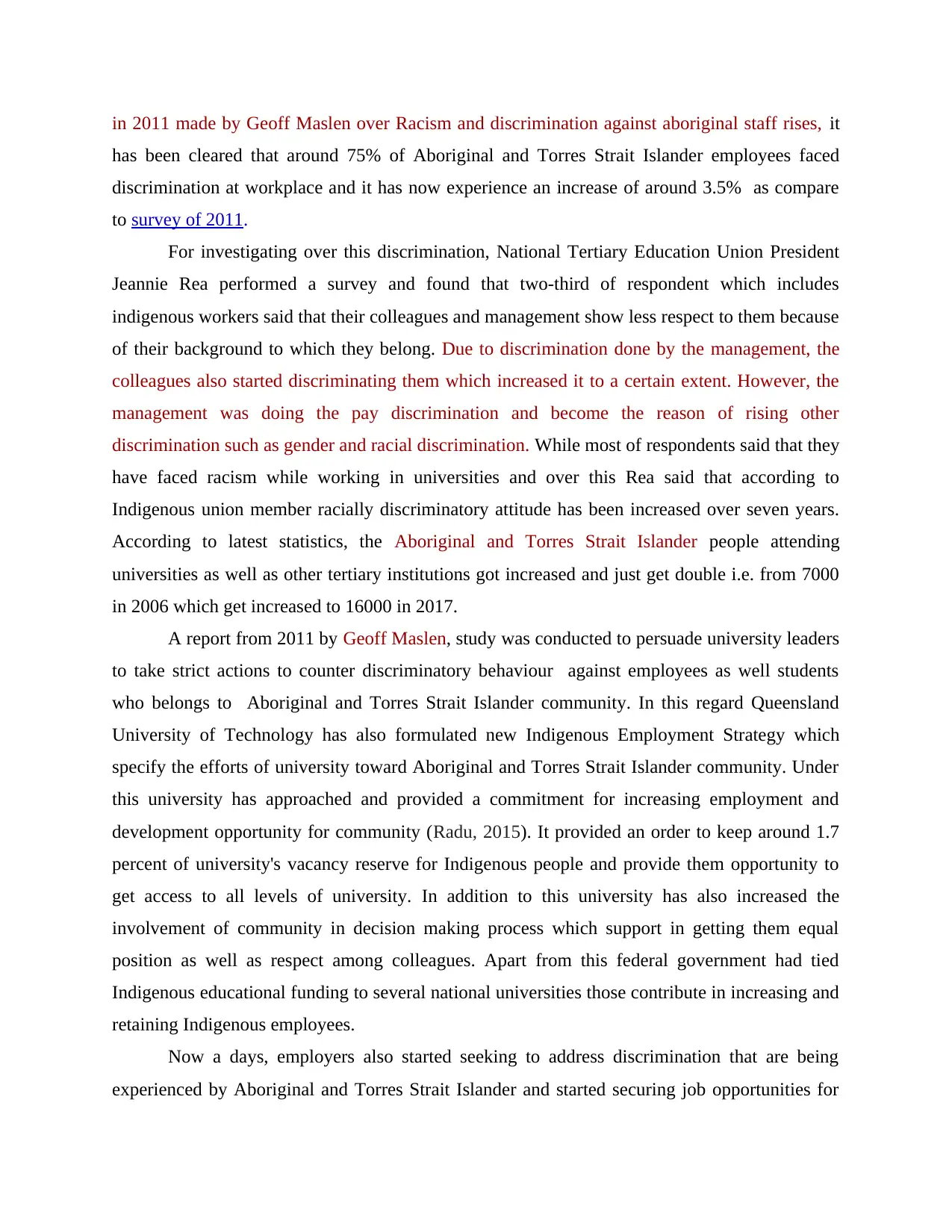
in 2011 made by Geoff Maslen over Racism and discrimination against aboriginal staff rises, it
has been cleared that around 75% of Aboriginal and Torres Strait Islander employees faced
discrimination at workplace and it has now experience an increase of around 3.5% as compare
to survey of 2011.
For investigating over this discrimination, National Tertiary Education Union President
Jeannie Rea performed a survey and found that two-third of respondent which includes
indigenous workers said that their colleagues and management show less respect to them because
of their background to which they belong. Due to discrimination done by the management, the
colleagues also started discriminating them which increased it to a certain extent. However, the
management was doing the pay discrimination and become the reason of rising other
discrimination such as gender and racial discrimination. While most of respondents said that they
have faced racism while working in universities and over this Rea said that according to
Indigenous union member racially discriminatory attitude has been increased over seven years.
According to latest statistics, the Aboriginal and Torres Strait Islander people attending
universities as well as other tertiary institutions got increased and just get double i.e. from 7000
in 2006 which get increased to 16000 in 2017.
A report from 2011 by Geoff Maslen, study was conducted to persuade university leaders
to take strict actions to counter discriminatory behaviour against employees as well students
who belongs to Aboriginal and Torres Strait Islander community. In this regard Queensland
University of Technology has also formulated new Indigenous Employment Strategy which
specify the efforts of university toward Aboriginal and Torres Strait Islander community. Under
this university has approached and provided a commitment for increasing employment and
development opportunity for community (Radu, 2015). It provided an order to keep around 1.7
percent of university's vacancy reserve for Indigenous people and provide them opportunity to
get access to all levels of university. In addition to this university has also increased the
involvement of community in decision making process which support in getting them equal
position as well as respect among colleagues. Apart from this federal government had tied
Indigenous educational funding to several national universities those contribute in increasing and
retaining Indigenous employees.
Now a days, employers also started seeking to address discrimination that are being
experienced by Aboriginal and Torres Strait Islander and started securing job opportunities for
has been cleared that around 75% of Aboriginal and Torres Strait Islander employees faced
discrimination at workplace and it has now experience an increase of around 3.5% as compare
to survey of 2011.
For investigating over this discrimination, National Tertiary Education Union President
Jeannie Rea performed a survey and found that two-third of respondent which includes
indigenous workers said that their colleagues and management show less respect to them because
of their background to which they belong. Due to discrimination done by the management, the
colleagues also started discriminating them which increased it to a certain extent. However, the
management was doing the pay discrimination and become the reason of rising other
discrimination such as gender and racial discrimination. While most of respondents said that they
have faced racism while working in universities and over this Rea said that according to
Indigenous union member racially discriminatory attitude has been increased over seven years.
According to latest statistics, the Aboriginal and Torres Strait Islander people attending
universities as well as other tertiary institutions got increased and just get double i.e. from 7000
in 2006 which get increased to 16000 in 2017.
A report from 2011 by Geoff Maslen, study was conducted to persuade university leaders
to take strict actions to counter discriminatory behaviour against employees as well students
who belongs to Aboriginal and Torres Strait Islander community. In this regard Queensland
University of Technology has also formulated new Indigenous Employment Strategy which
specify the efforts of university toward Aboriginal and Torres Strait Islander community. Under
this university has approached and provided a commitment for increasing employment and
development opportunity for community (Radu, 2015). It provided an order to keep around 1.7
percent of university's vacancy reserve for Indigenous people and provide them opportunity to
get access to all levels of university. In addition to this university has also increased the
involvement of community in decision making process which support in getting them equal
position as well as respect among colleagues. Apart from this federal government had tied
Indigenous educational funding to several national universities those contribute in increasing and
retaining Indigenous employees.
Now a days, employers also started seeking to address discrimination that are being
experienced by Aboriginal and Torres Strait Islander and started securing job opportunities for
⊘ This is a preview!⊘
Do you want full access?
Subscribe today to unlock all pages.

Trusted by 1+ million students worldwide
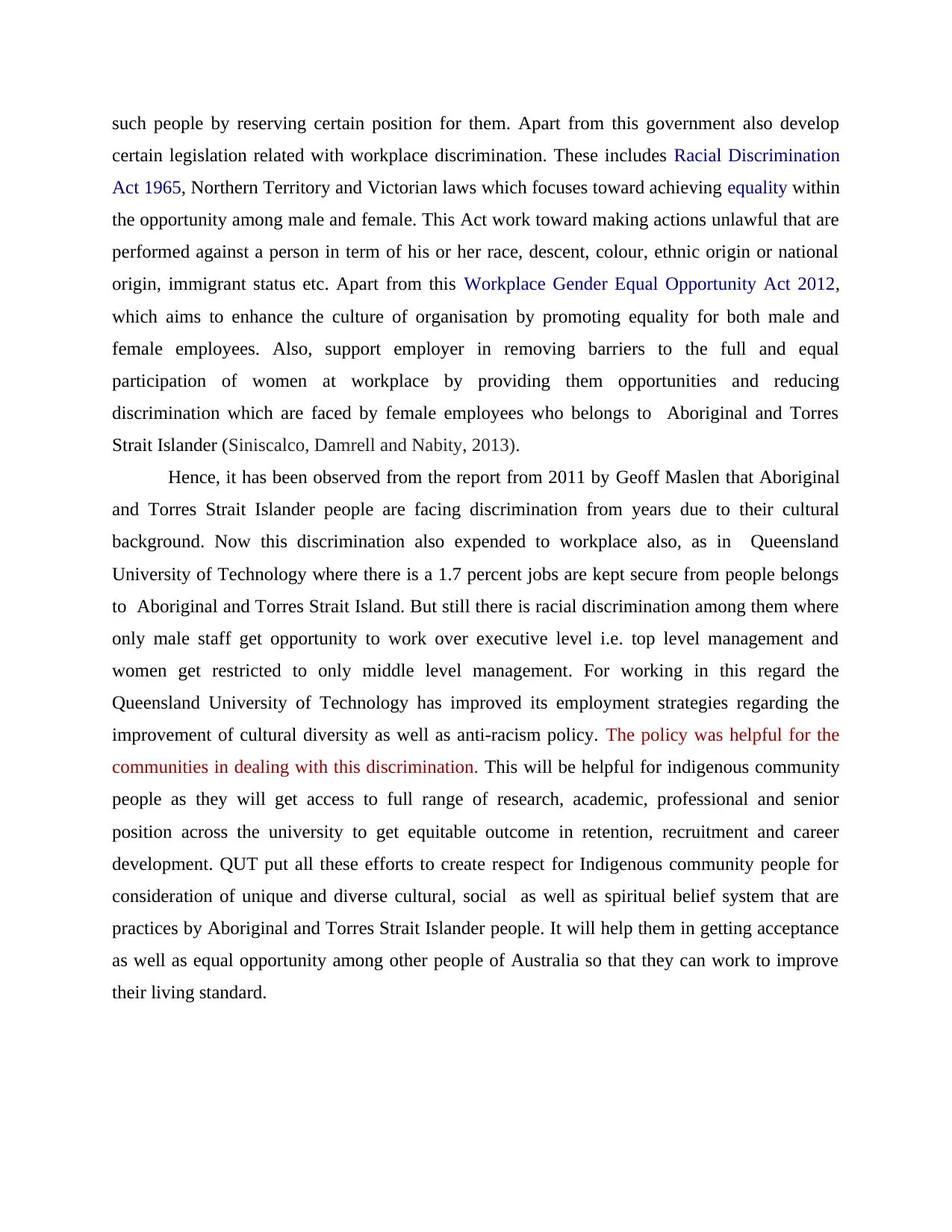
such people by reserving certain position for them. Apart from this government also develop
certain legislation related with workplace discrimination. These includes Racial Discrimination
Act 1965, Northern Territory and Victorian laws which focuses toward achieving equality within
the opportunity among male and female. This Act work toward making actions unlawful that are
performed against a person in term of his or her race, descent, colour, ethnic origin or national
origin, immigrant status etc. Apart from this Workplace Gender Equal Opportunity Act 2012,
which aims to enhance the culture of organisation by promoting equality for both male and
female employees. Also, support employer in removing barriers to the full and equal
participation of women at workplace by providing them opportunities and reducing
discrimination which are faced by female employees who belongs to Aboriginal and Torres
Strait Islander (Siniscalco, Damrell and Nabity, 2013).
Hence, it has been observed from the report from 2011 by Geoff Maslen that Aboriginal
and Torres Strait Islander people are facing discrimination from years due to their cultural
background. Now this discrimination also expended to workplace also, as in Queensland
University of Technology where there is a 1.7 percent jobs are kept secure from people belongs
to Aboriginal and Torres Strait Island. But still there is racial discrimination among them where
only male staff get opportunity to work over executive level i.e. top level management and
women get restricted to only middle level management. For working in this regard the
Queensland University of Technology has improved its employment strategies regarding the
improvement of cultural diversity as well as anti-racism policy. The policy was helpful for the
communities in dealing with this discrimination. This will be helpful for indigenous community
people as they will get access to full range of research, academic, professional and senior
position across the university to get equitable outcome in retention, recruitment and career
development. QUT put all these efforts to create respect for Indigenous community people for
consideration of unique and diverse cultural, social as well as spiritual belief system that are
practices by Aboriginal and Torres Strait Islander people. It will help them in getting acceptance
as well as equal opportunity among other people of Australia so that they can work to improve
their living standard.
certain legislation related with workplace discrimination. These includes Racial Discrimination
Act 1965, Northern Territory and Victorian laws which focuses toward achieving equality within
the opportunity among male and female. This Act work toward making actions unlawful that are
performed against a person in term of his or her race, descent, colour, ethnic origin or national
origin, immigrant status etc. Apart from this Workplace Gender Equal Opportunity Act 2012,
which aims to enhance the culture of organisation by promoting equality for both male and
female employees. Also, support employer in removing barriers to the full and equal
participation of women at workplace by providing them opportunities and reducing
discrimination which are faced by female employees who belongs to Aboriginal and Torres
Strait Islander (Siniscalco, Damrell and Nabity, 2013).
Hence, it has been observed from the report from 2011 by Geoff Maslen that Aboriginal
and Torres Strait Islander people are facing discrimination from years due to their cultural
background. Now this discrimination also expended to workplace also, as in Queensland
University of Technology where there is a 1.7 percent jobs are kept secure from people belongs
to Aboriginal and Torres Strait Island. But still there is racial discrimination among them where
only male staff get opportunity to work over executive level i.e. top level management and
women get restricted to only middle level management. For working in this regard the
Queensland University of Technology has improved its employment strategies regarding the
improvement of cultural diversity as well as anti-racism policy. The policy was helpful for the
communities in dealing with this discrimination. This will be helpful for indigenous community
people as they will get access to full range of research, academic, professional and senior
position across the university to get equitable outcome in retention, recruitment and career
development. QUT put all these efforts to create respect for Indigenous community people for
consideration of unique and diverse cultural, social as well as spiritual belief system that are
practices by Aboriginal and Torres Strait Islander people. It will help them in getting acceptance
as well as equal opportunity among other people of Australia so that they can work to improve
their living standard.
Paraphrase This Document
Need a fresh take? Get an instant paraphrase of this document with our AI Paraphraser
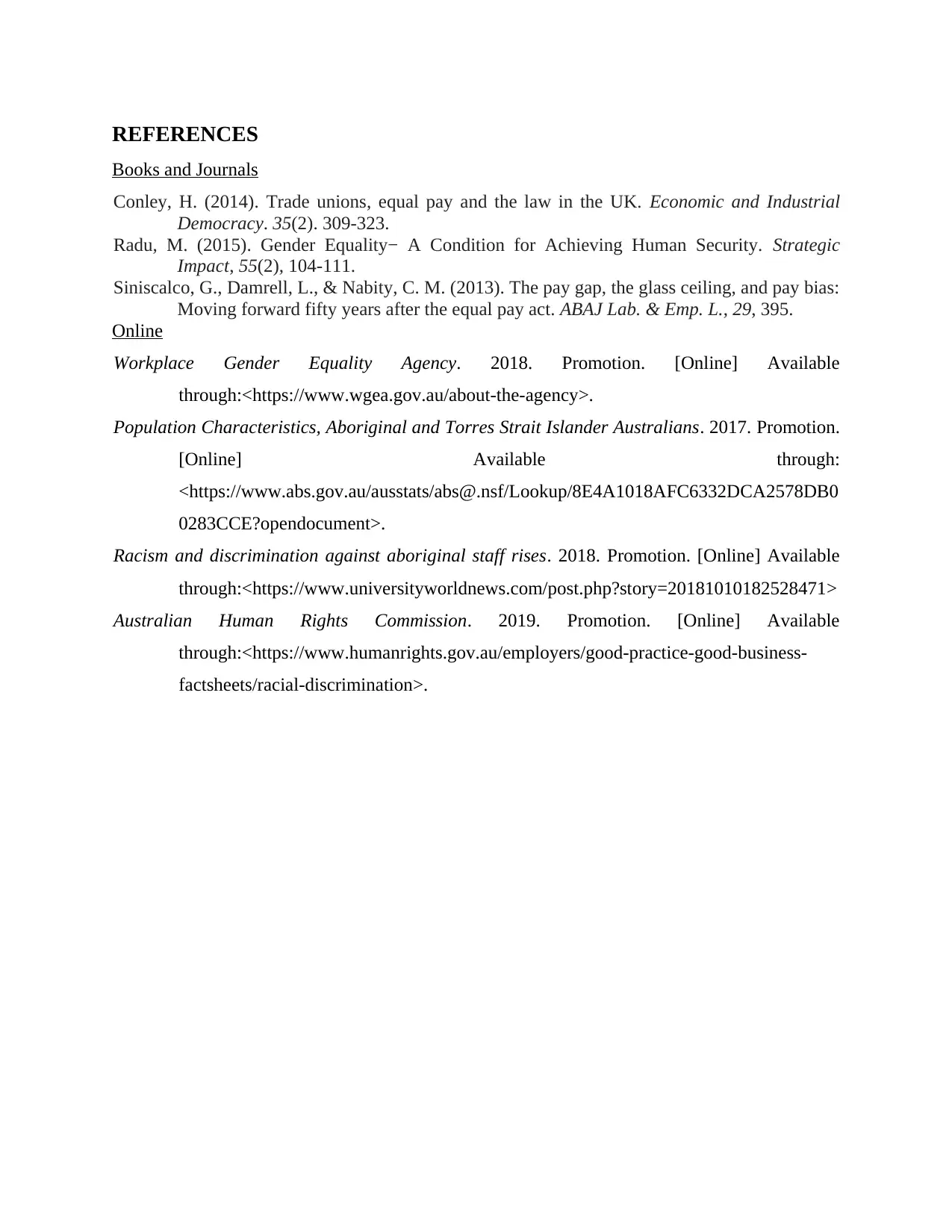
REFERENCES
Books and Journals
Conley, H. (2014). Trade unions, equal pay and the law in the UK. Economic and Industrial
Democracy. 35(2). 309-323.
Radu, M. (2015). Gender Equality− A Condition for Achieving Human Security. Strategic
Impact, 55(2), 104-111.
Siniscalco, G., Damrell, L., & Nabity, C. M. (2013). The pay gap, the glass ceiling, and pay bias:
Moving forward fifty years after the equal pay act. ABAJ Lab. & Emp. L., 29, 395.
Online
Workplace Gender Equality Agency. 2018. Promotion. [Online] Available
through:<https://www.wgea.gov.au/about-the-agency>.
Population Characteristics, Aboriginal and Torres Strait Islander Australians. 2017. Promotion.
[Online] Available through:
<https://www.abs.gov.au/ausstats/abs@.nsf/Lookup/8E4A1018AFC6332DCA2578DB0
0283CCE?opendocument>.
Racism and discrimination against aboriginal staff rises. 2018. Promotion. [Online] Available
through:<https://www.universityworldnews.com/post.php?story=20181010182528471>
Australian Human Rights Commission. 2019. Promotion. [Online] Available
through:<https://www.humanrights.gov.au/employers/good-practice-good-business-
factsheets/racial-discrimination>.
Books and Journals
Conley, H. (2014). Trade unions, equal pay and the law in the UK. Economic and Industrial
Democracy. 35(2). 309-323.
Radu, M. (2015). Gender Equality− A Condition for Achieving Human Security. Strategic
Impact, 55(2), 104-111.
Siniscalco, G., Damrell, L., & Nabity, C. M. (2013). The pay gap, the glass ceiling, and pay bias:
Moving forward fifty years after the equal pay act. ABAJ Lab. & Emp. L., 29, 395.
Online
Workplace Gender Equality Agency. 2018. Promotion. [Online] Available
through:<https://www.wgea.gov.au/about-the-agency>.
Population Characteristics, Aboriginal and Torres Strait Islander Australians. 2017. Promotion.
[Online] Available through:
<https://www.abs.gov.au/ausstats/abs@.nsf/Lookup/8E4A1018AFC6332DCA2578DB0
0283CCE?opendocument>.
Racism and discrimination against aboriginal staff rises. 2018. Promotion. [Online] Available
through:<https://www.universityworldnews.com/post.php?story=20181010182528471>
Australian Human Rights Commission. 2019. Promotion. [Online] Available
through:<https://www.humanrights.gov.au/employers/good-practice-good-business-
factsheets/racial-discrimination>.
1 out of 5
Related Documents
Your All-in-One AI-Powered Toolkit for Academic Success.
+13062052269
info@desklib.com
Available 24*7 on WhatsApp / Email
![[object Object]](/_next/static/media/star-bottom.7253800d.svg)
Unlock your academic potential
Copyright © 2020–2025 A2Z Services. All Rights Reserved. Developed and managed by ZUCOL.





